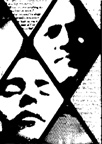How do you get the faces on
the glass?
The stained glass panels that
feature images of faces and text (such as the Melville,
Four
Women and Eight Faces panels) use a unique process developed
by Tom Krepcio involving computer imaging combined with screenprinting and some brushwork
by hand, akin to a monoprinting process in printmaking.
Will the paint wear off? (is
it permanent?)
The paint used for the all
the panels, including the quarry faces, is the same used in the Gothic Cathedrals
and will last for centuries. After being fired to a temperature of 1200 degrees fahrenheit
the paint becomes a permanent part of the glass, impervious to the elements.
Where do you get your glass?
I use only the finest sheet
glass from Europe and the U.S. - with a preference for handblown glasses. I am especially
fond of using flashed glasses. A flashed glass is a flat sheet of glass that has
been blown with a thick base of clear (or light color) glass and a thin layer of
deep colored glass. This thin layer of deep colored glass can be acid etched, engraved
or blasted off giving a two color effect in a single piece of glass. For a more detailed
description of how handblown sheet glass is made visit the Lambert's
website.
How do you create the effect
of several colors in a small area (such as in 'three figures')?
The multiple layer panels (such
as the Drawn
Face, Three Figures,
Three
Faces, Pink Angel
and Hollyhocks Panels) represent the way I use the
computer to simulate a four color printing process using layers of flashed glass.
A color photograph or drawing is scanned into a computer. The image is manipulated
to size and color balance, then color separated and used to make individual silkscreens.
The silkscreens corresponding to cyan, magenta and yellow are used to screen a resist
on to flashed blue, red and yellow glass. These pieces of glass with resist are sandblasted,
then fire polished. The silkscreen corresponding to black is used to screen a layer
of black vitreous paint onto the blue layer. After this last layer is fired in the
kiln, all the layers are placed together. The process lends itself to different variations
of the same design, as well as dramatic light effects. Look at the 'story' of the Pink Angel panel for some idea of the process.
Where do you buy that patterned
glass used in the patchwork pieces?
The flashed glass that I start
with is readily available - however, I create all the designs and patterns on the
pieces of glass. All are either acid etched, sandblasted or engraved by me. The individual
pieces of glass in the patchwork
panels and patchwork
boxes represent a crazy
quilt of my career. That is to say, the pieces are accumulated from tests, extras
and unused pieces from older panels and boxes. Check out the pdf documents on the
Patchwork
Box MJ page. This 'legend'
shows the source of all the individual pieces of glass in this box.
Why is it called 'stained'
glass?
The term 'stained glass' is
a bit of a misnomer, as the staining of glass only refers to one (now relatively
obscure) technique known as silver staining, where silver nitrate is applied to the
glass and fired at a low temperature to produce a yellow stain on the glass (seen
in the Hollyhocks) . There are not many studios who use
this process any more on a regular basis and the majority of the stained glass seen
today does not feature this technique at all. The glass used today is sometimes referred
to as 'pot metal', because the color in the glass is introduced in the pot of the
furnace. Again, for a good description of the process of making hand blown sheet
glass, visit the Lambert's site.
Do you do workshops?
Information on recent workshops
can be found on the Tom
Krepcio Workshops page.
If you are interested in attending a workshop or simply want to be kept posted on
developments check there or contact me at tom@krepcio.com.
I am also available to do individual tutoring and consultation.
What most determines the cost
of a piece?
In a single word, complexity.
The size of a piece is important and using the best quality material does bring the
price up somewhat but these are nothing compared to complexity. This involves not
only how many pieces per foot (or per inch), but alos what techniques are used as
well as the cost of development and research for new processes, etc. These all factor
in to the overall notion of how complex a given piece is.
home - gallery
- sitemap
|
